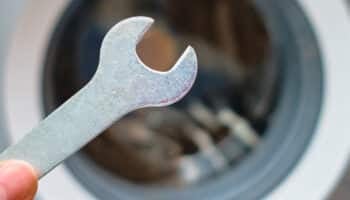We've independently reviewed this article to make sure it's as accurate as we can make it.
To find out more about our article creation and review process, check out our editorial guidelines.
Stuck trying to figure out why your dryer is making holes in your clothes?
You’re not alone! I know how annoying it can be to discover holes in your clothes after running them through the dryer, especially when it’s your favorite t-shirt or another cherished item.
Luckily, you’ve come to the right place to get the issue fixed. The following guide will explore how a washing dryer machine works, why it’s putting holes in your clothes, and what you can do about it.
Torn clothes from a dryer is most commonly caused by sharp edges on the drum. If not the drum, then the paddles. Gently feeling around the drum for sharp indents may help you find the cause.
Read on and I’ll walk you through all the potential causes and solutions in detail!
Why trust us? This article was written by Craig Anderson and Andy Fulenchek.
Craig has helped thousands of other homeowners repair their appliances since 2016.
Andy is one of our resident appliance repair experts with over a decade of experience. He currently runs his appliance repair company with a team of trusted technicians.
7 Reasons Why Your Clothes Have Holes or Rip After Using Your Dryer
If you notice that your dryer is putting holes in your clothes, the problem doesn’t fall entirely on your washing machine. There’s also a chance that you’ve not set the program correctly or you have used the wrong detergent.
Here’s a detailed overview of the reasons why your clothes have holes or rips when using your dryer.
#1 Your Door Seal May Be Damaged
If your dryer is putting holes in your clothes, your gasket might be damaged. Many front-loading machines feature a large book or rubber gasket, which ensures that clothes don’t get stuck between the edge of the drum and the door seal.
In my experience, when the seal gets damaged or worn out, your clothes will be snagged between the door seal and the drum—eventually resulting in holes in your clothes.
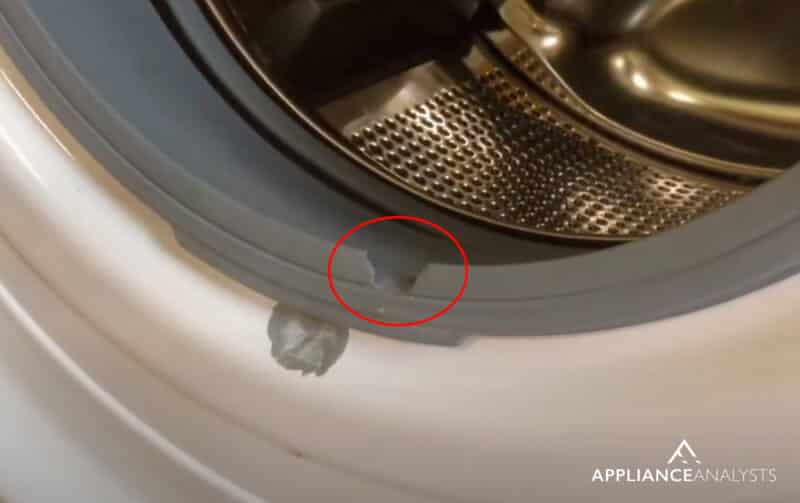
At the first sign of a failing door seal, make sure that you replace it immediately to prevent further damage to your clothes.
If you want to get any replacement part – or see how much one would cost – click to enter your model number in the search bar below. Our partners at AppliancePartsPros stock almost every part with free guides on how to install them.

#2 Drum Imperfections
Your dryer drums are likely failing if you notice that your dryer is ripping holes in your clothes regularly.
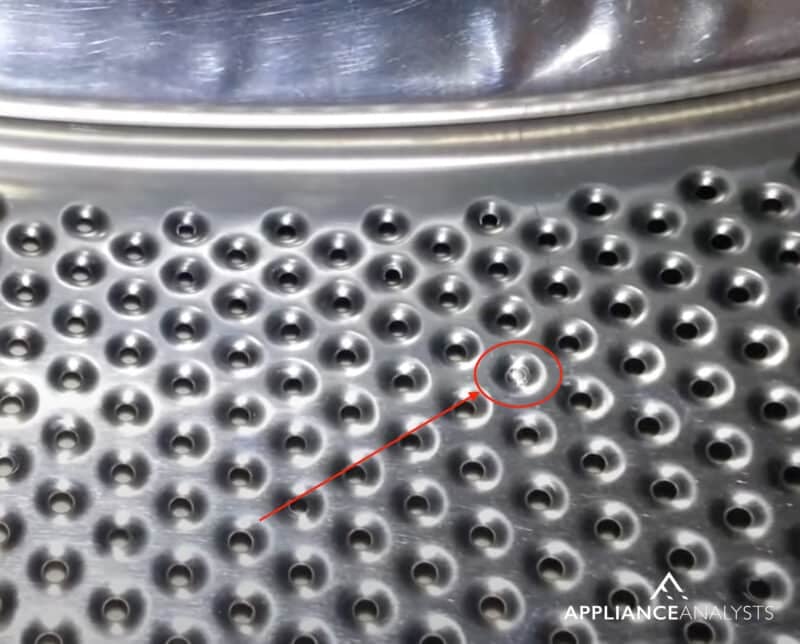
Gently run your hand around the drum and look for imperfections like the one above. If you run your finger across it and it scrapes against you, that’s probably what’s tearing up your clothes.
The bad news is this is a tricky fix. If your dryer is under warranty you may be able to get a replacement, because it’s safe to say that replacing a whole drum is a huge job!
If it’s out of warranty, you may be able to MacGyver together a fix with a screwdriver head and a hammer to force the metal down.
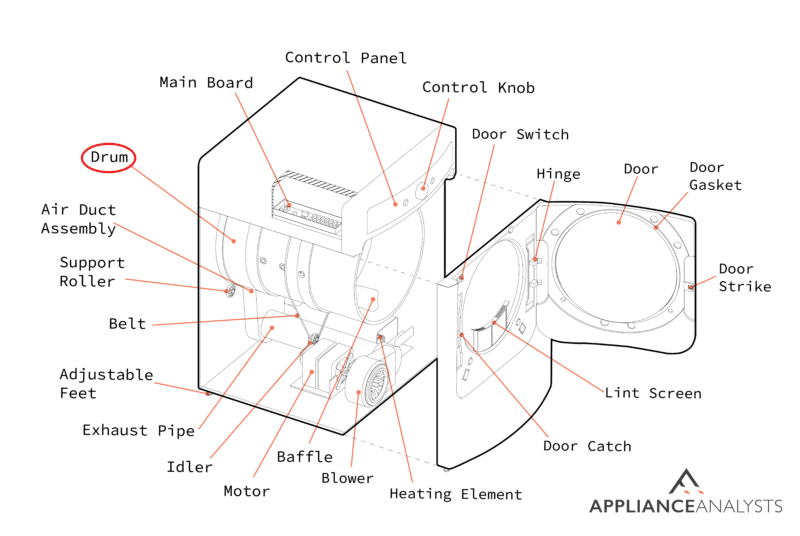
However, if you notice one imperfection then there may be a pattern. Look for other imperfections in similar spots in the drum. Where there’s one, there are often others spaced out around the drum from a bad machine in the factory.
#3 Failing To Use the Recommended Spin Cycle Speeds
When using a washer-dryer combo, you must ensure you use the correct speed for your clothes’ fabric type. Otherwise, your dryer will end up putting holes in your clothes.
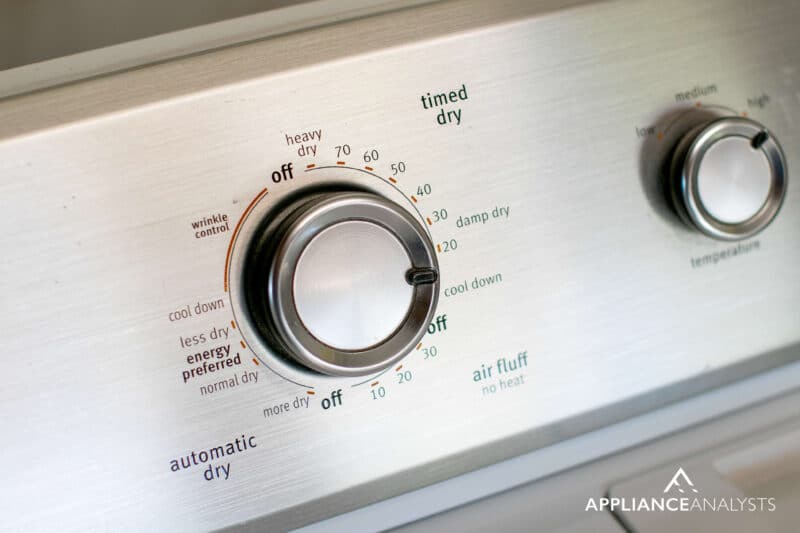
If you’re washing cotton clothes, I don’t recommend washing them at more than 600 revolutions per minute. As for towels and sheets, I find that it’s okay to use speeds of up to 1,400 revolutions per minute.
Make sure you don’t turn your clothes at high speed. The ideal speed to clean your jeans is 900 revolutions per minute. If you have silk fabric, set a cycle at 400 revolutions per minute. By doing so, your clothes can enter into tiny crevices and holes in your washer drum and cause wear and tear.
#4 Using Too Much Chlorine Bleach
If you use a lot of chlorine when doing laundry, that’s likely what’s putting holes in your clothes.
A common sign of bleach-related holes includes yellow discoloration with weak edges. If you want to avoid such damage to your clothes, you should follow the manufacturer’s instructions on using detergents.
#5 Failing to Zip Up Jackets or Inspect the Pockets
When using your washer, you should always zip up. If you haven’t fastened up zips on your clothes, they may end up tearing lighter clothes as they spin. Leaving screws, pins, and nails inside your clothes pockets can also damage them during a drying cycle.
Therefore, if your clothes have small holes after using your dryer, make sure that you check your washing machine’s filter.
Checking the filter will ensure that no object can catch your clothes. Still, don’t forget to check for ornaments or pins inside the pockets before you wash your clothes.
#6 Damage From Bra Underwire
If the underwire from your bra is missing when you’re doing laundry, it could explain why your dryer is putting holes in your clothes. The underwire is likely caught between the side of the washer and the drum, damaging your clothes as they turn.
When you suspect that your bra’s underwire is causing holes in your clothes, open the casing of your washer and immediately pull out the wire.
A bra underwire can not only damage your clothes, but it can also puncture the tub, damage the pump rubber hoses, cause water leaks, or become lodged in the drain pump.
#7 Failing to Clear Your Lint Screen
Your dryer lint screen is located at the side or bottom of your dryer door, and you need to clean it after every cycle to keep your dryer from ripping holes in your clothes.
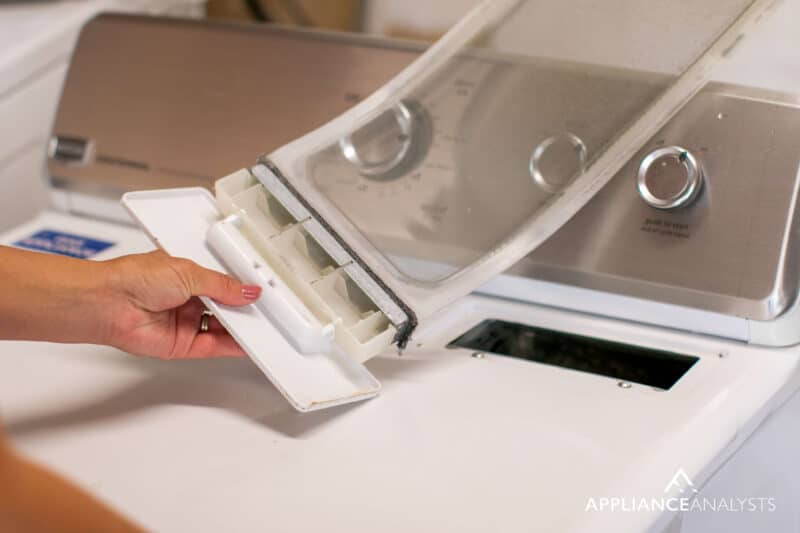
If you clean the lint screen, there will be lint buildup which will obstruct proper airflow. Poor airflow will then increase your dryer’s internal temperature, which may leave burnt holes in your clothes.
5 Ways to Prevent Your Washer-Dryer from Tearing Holes on Your Clothes
To prevent your dryer from tearing holes in your clothes, here are some useful tips you should follow when using your washer-dryer combo.
#1 Avoid Overloading Your Appliance
You may put a lot of clothes in your washing machine to save time washing your clothes. When you overload your dryer, you put pressure on the motor, drum, and bearing, causing your machine to disintegrate gradually.
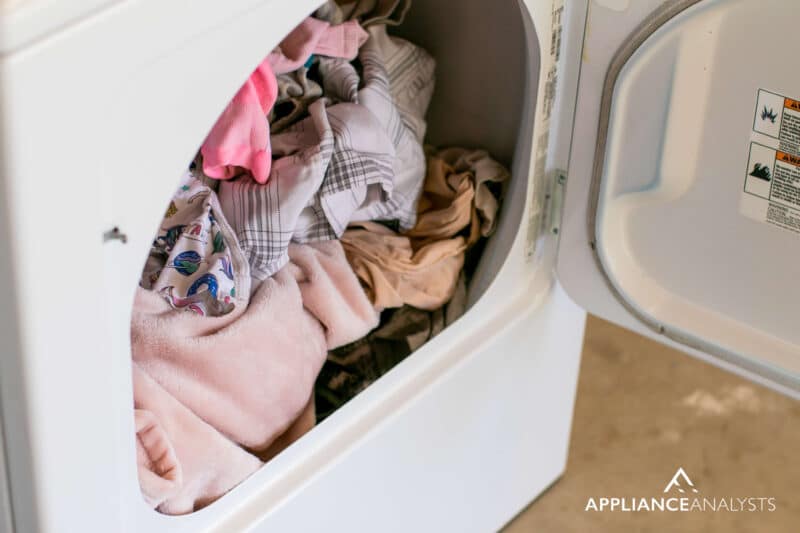
If you continue to use your dryer, it can begin to pull some clothes into the door, thus tearing holes in your clothes. If you want to avoid damaging your dryer, it’s advisable to wash your clothes in batches.
#2 Use The Correct Cycle
The speed cycle you set should match your fabric type.
- Normal Cycle – The cycle spins fast and is ideal for regularly cleaning sweaty clothes — fabric types such as bedding, towels, denim, and linen work well under a normal cycle.
- Perm Press Cycle – A cleaning cycle that alternates between slow and fast. The slow spins prevent wrinkles or pilling. It would be best if you switched to faster speeds for clothes requiring fast cleaning agitation. Examples of such fabric include synthetic fibers like polyesters, knits, and rayons.
- Delicate Cycle – A slow spin cycle designed to prevent wear and tear and reduce agitation. Best suited for woven fabric and sequined clothing.
- Special Cycle – Latest washing machines have steam or sanitize, among other functions. So, it’s essential to consult your manual to find out the unique features of your washing machine.
#3 Use the Right Amount of Detergent
Before using any detergent, you must know where to put it and how much your machine can handle. The back label of most cleaning products will indicate the right amount to use.
You should also check if your washing machine has a label indicating the detergent type and the amount to use.
Additionally, consider adding a detergent before loading your clothes. Adding detergent before washing your clothes will prevent damage or staining your clothes. Turning on the water to dissolve the detergent before loading your clothes is also best.
Many front-loading washing machines have a drawer where you can dispense detergent. There will also be a separate compartment to place your bleach or fabric softener. In the top-loading washing machines, you’ll need to put detergent into the drum before you start cycling. These are essential steps to follow if you want to prevent the detergent from damaging your clothes.
#4 Check The Care Instructions On Your Clothes
Please ensure you read the care label on your machine before you toss them in.
Some fabrics will shrink when heat-dried or washed in warm water, while others shouldn’t be spin-dried. Others, such as silk and lace, should not be machine-washed together.
#5 Use a Mesh Wash Bag When Washing Delicate Clothes
If you’re washing delicate clothes, especially those made of linen or chiffon, place them into a mesh wash bag to prevent wear and tear.
Additionally, if you have color-bleeding garments, you must use them with other color-bleeding loads.
How Does A Washing Machine Dryer Work?
There are two types of washing machine/dryer combination units; vented and ventless. A distinct trait of a vented system is that the wash cycle will tumble your clothes with water and soap until they’re clean. The dryer unit then spins to remove the excess water from your clothes.
When drying your clothes, the machine will take excess air from the surroundings and heat it. Then, the dryer will spin your clothes in the hot air, picking up the moisture. The process will generate steam that will leave your room through the vent. Your dryer will then take new air from the surroundings and repeat the process.
You don’t require an outside exhaust when it comes to ventless washing machine dryers. You have to put clothes in the drum, cool your dryer condensing chamber, and heat the air inside the dryer drum.
As the drum spins, the heated air takes up moisture from your clothes, and the moist air is turned into liquid.
The condensation process then leaves your unit via the water drainage tube. The dry air is then recirculated with your clothes, repeating the process.
Preventing Your Dryer From Putting Holes in Your Clothes
Putting a lot of clothes in a washer-dryer machine may seem a convenient way to clean plenty of clothes in a short time. However, such a practice will overload your appliance, damaging its components and your clothes. For example, top and front load machines can have failed bearings/seals due to excessive weight.
In addition to overloading your machine, you can damage your clothes if you don’t use the correct amount of detergents and bleach.
Checking the clothes pockets for pins or sharp objects is also essential. Also, ensure you zip up the pockets to avoid the dryer tearing holes in your clothes.
Any of the mentioned issues can cause dryer tearing holes in your clothes. Fortunately, you can fix the problem quickly by using the dryer correctly.
Thanks for reading. If this article was useful, please check out our other resources below and consider subscribing to our newsletter.
Happy drying!
-Craig.







